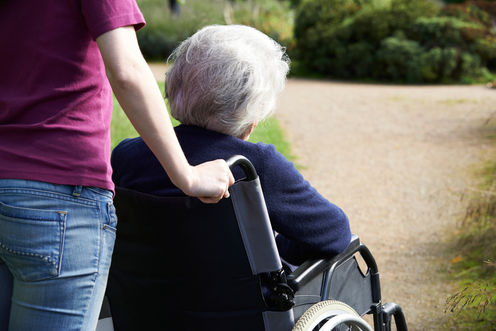 comm
commDementia can affect the ability to perform tasks such as dressing, showering and eating. from shutterstock.com
This is the third in the How Australians Die series that focuses on the country’s top five causes of death and how we can drive down rates of these illnesses. Tomorrow’s piece will explore the fourth leading cause of death: chronic lower respiratory diseases. You can read yesterday’s piece on cancers here.
In Australia, dementia is the third leading cause of death after heart disease and cancers. Typically, people with dementia deteriorate gradually and eventually die from complications such as respiratory failure – from pneumonia for instance – or other infections. Dementia will in these cases be registered as the underlying cause of death.

Dementia is a general term for severe disorders with mental decline. Subtypes include Lewy body dementia, vascular dementia (with cerebrovascular disease) and fronto-temporal dementia. Of these types, Alzheimer’s disease is the most common diagnosis of dementia, accounting for 50-75% of all cases. As such, Alzheimer’s disease and dementia are often used interchangeably.
As the population ages, the number of people with dementia is expected to rise, as is the number of deaths caused by the disease.
History of Alzheimer’s dementia
Alzheimer’s disease was first reported by German psychiatrist Alöis Alzheimer in 1906. After comparing autopsy reports of some of his patients, he described the presence of two abnormal brain structures made up of accumulated clusters of sticky proteins between nerve cells.
These abnormally accumulated proteins are considered the classic pathological hallmarks of the disease.

About 5% of dementia cases show early onset or familial inheritance, where dementia develops before the age of 65, sometimes in adults as young as 35. However, the disease most commonly presents as the age-related dementia with which we are familiar.
The frequency of the disease is markedly increased in adults over 65. After this age, it doubles every six-and-a-half years. It ultimately affects one-third of those older than 85.
Dementia signs and symptoms
Dementia can take several years to develop. It is often categorised as mild (early stage), moderate (mid stage) and advanced (late stage). Symptoms include:
- cognitive impairment: problems with memory, communication, comprehension and ability to recognise familiar objects and people
- psychiatric or behavioural symptoms: severe depression, delusions and hallucinations (visual and auditory), and increased aimless wandering, agitation and confusion
- dysfunction in daily living activities: in the earlier stages of dementia, the ability to perform routine tasks such as shopping may be disrupted. Dementia in the later stages can affect the ability to perform more basic tasks such as dressing, showering and eating.
People living with dementia may have different symptoms at various times, depending on the person and the parts of the brain affected.
There is no single established screening test to accurately diagnose dementia. Neurologists use reports from physical examinations, memory or cognitive tests, caregiver interviews, questionnaires, medical histories, genetic tests and brain scans.
Risks of dementia include having a family history of the disorder, a history of repeated head trauma and lifestyle factors, such as hypertension, uncontrolled diabetes, high cholesterol, poor cardiovascular fitness and atherosclerosis. Moderate exercise and controlled weight can reduce the risks of cognitive impairment and dementia.
Studies have also shown being female can put you at higher risk of cognitive decline. The exact reasons for this are somewhat controversial. It could be because risk increases with age and women tend to outlive men.
But some evidence shows that the risk increases parallel to a reduction in female hormone production after menopause, so the incidence is slightly higher in women after the age of 75. Female hormones are known to play a protective role in cardiovascular function, cognition and memory.
Disease burden
It is estimated that, in 2015, 47 million people had dementia globally. These numbers are projected to double every two decades and reach 131.5 million by 2050.
In the United States, dementia was the second leading cause of death after heart disease in 2014. While the number of deaths from dementia increased by 119% from the year 2000, rates of deaths from heart disease dropped by 24% over the same period.
The number of Australians living with dementia is more than 353,800 (around 15% of the total population). This is projected to increase to 553,000 by 2030. The projections may be conservative as the current number is actually higher than the number (329,243) projected in 2011.
The total direct cost of dementia to the Australian health and aged care system was estimated to be more than A$4.9 billion in the 2009-10 financial year. Nearly 59% of residential aged care expenditure was spent on dementia patients in June 2009.
A firm diagnosis usually occurs three years after noticeable symptoms are manifested and noticed by family members. This is often at the early to mid stage of the disease. From this stage, the only management available is the possible alleviation of symptoms with prescription drugs – although depending on the person and disease severity, these might help little.
It is critical we identify those at risk so that timely medical interventions can be provided before dementia onset, with the possibility of delaying the onset. This would considerably reduce the time people live with dementia and the overall associated disease burden. It’s estimated a delay of dementia onset by five years would reduce the number of cases by a third.
The best current approach to the dementia epidemic is to promote a healthy lifestyle from an early age as poor cardiovascular fitness in teenage years is predicted to increase dementia risk.
Siva Purushothuman receives funding from National Health and Medical Research Council (NHMRC) & Australian Research Council (ARC).
